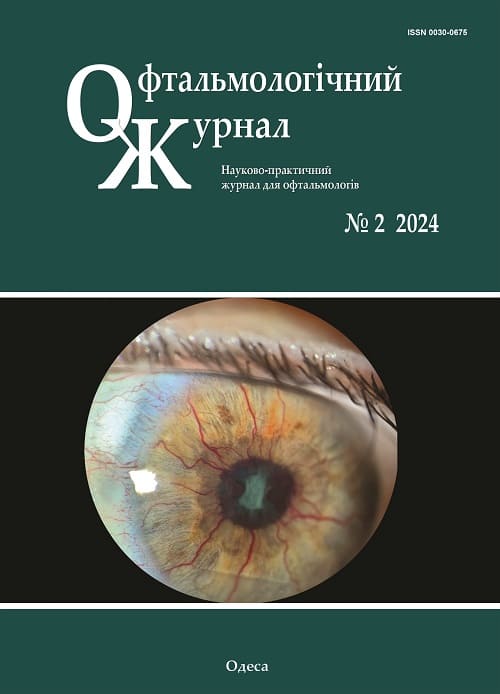Ophthalmic symptoms before and after surgery for tuberculum sellae meningioma
DOI:
https://doi.org/10.31288/oftalmolzh202422531Keywords:
tuberculum sellae meningioma, optic atrophy, bitemporal heteronymous hemianopia, endoscopic transnasal surgeryAbstract
Purpose: To review the features of ophthalmic symptoms before and after surgery for tuberculum sellae meningioma (TSM).
Material and Methods: We reviewed the results of diagnostic assessment and outcomes of 91 patients ((182 eyes; 70 (76.9%) women and 21 (23.1%) men; mean age, 48.4% ± 1.7 years) treated for TSM with or without diaphragm sellae involvement at the Romodanov institute during 2014 through 2023.
Patients underwent clinical neurological and eye examination and neuroimaging procedures.
The results were reviewed for analysis and generalization of visual functions to calculate visual abnormality scores as per the guidelines of the German Ophthalmological Society.
Results: Asymmetric visual field defects were observed in 41 (45.1%) patients with a bilateral disease, and unilateral visual field defects, in 23 (25.3%) patients, which was caused by both tumor compression of the anterior chiasm and optic canal invasion. Of the 74 (81.3%) patients with optic atrophy, 45 had unilateral optic atrophy, and 29, bilateral optic atrophy. Postoperatively, visual function improved, worsened and did not change in 72.5%, 7.7%, and 19.8% of patients, respectively.
Conclusion: The approach to TSM resection should be tailored to the degree of optic canal invasion, tumor size and tumor relationship with the surrounding neural and vascular structures. On this basis, transcranial resection was performed in 68.1%, and endoscopic endonasal resection of TSM, in 31.9% of patients. The mean visual acuity improved from 0.44 ± 0.07 at preoperative to 0.69 ± 0.04 at postoperative evaluation (p < 0.001), and the average mean defect (MD) improved from 15.34 ± 0.78 dB at preoperative to 9.14 ± 0.64 dB at postoperative evaluation (p < 0.001).
References
Amirjamshidi A, Mortazavi SA, Shirani M, Saeedinia S, Hanif H. Coexisting pituitary adenoma and suprasellar meningioma-a coincidence or causation effect: report of two cases and review of the literature. J Surg Case Rep. 2017 May 22;2017(5):rjx039. https://doi.org/10.1093/jscr/rjx039
Terrier LM, François P. Meningiomas multiples [Multiple meningiomas]. Neurochirurgie. 2016;62(3):128-135. https://doi.org/10.1016/j.neuchi.2015.12.006
Asa SL, Mete O, Cusimano MD, et al. Pituitary neuroendocrine tumors: a model for neuroendocrine tumor classification. Mod Pathol. 2021;34(9):1634-1650. https://doi.org/10.1038/s41379-021-00820-y
Rohringer M, Sutherland GR, Louw DF, Sima AAF. Incidence and clinicopathological features of meningioma. J Neurosurg. 1989;71:665-672. https://doi.org/10.3171/jns.1989.71.5.0665
Kwancharoen R, Blitz AM, Tavares F, Caturegli P, Gallia GL, Salvatori R. Clinical features of sellar and suprasellar meningiomas. Pituitary. 2014 Aug;17(4):342-8. PMID: 23975080. https://doi.org/10.1007/s11102-013-0507-z
Magill ST, McDermott MW. Tuberculum sellae meningiomas. Handb Clin Neurol. 2020;170:13-23. https://doi.org/10.1016/B978-0-12-822198-3.00024-0
Mariniello G, Bonavolontà G, Tranfa F, Maiuri F. Management of the optic canal invasion and visual outcome in spheno-orbital meningiomas. Clin Neurol Neurosurg. 2013 Sep;115(9):1615-20. Epub 2013 Mar 7. https://doi.org/10.1016/j.clineuro.2013.02.012
Andrews BT, Wilson CB. Suprasellar meningiomas: the effect of tumor location on postoperative visual outcome. J Neurosurg. 1988 Oct;69(4):523-8. https://doi.org/10.3171/jns.1988.69.4.0523
Goel A, Muzumdar D, Desai KI. Tuberculum sellae meningioma: a report on management on the basis of a surgical experience with 70 patients. Neurosurgery. 2002 Dec;51(6):1358-63; discussion 1363-4. PMID: 12445340. https://doi.org/10.1097/00006123-200212000-00005
Sklar EM, Schatz NJ, Glaser JS, Sternau L, Seffo F. Optic tract edema in a meningioma of the tuberculum sellae. AJNR Am J Neuroradiol. 2000 Oct;21(9):1661-3. PMID: 11039346; PMCID: PMC8174852.
Grisoli F, Diaz-Vasquez P, Riss M, Vincentelli F, Leclercq TA, Hassoun J, Salamon G. Microsurgical management of tuberculum sellae meningiomas. Results in 28 consecutive cases. Surg Neurol. 1986 Jul;26(1):37-44. https://doi.org/10.1016/0090-3019(86)90061-3
Harati O, Boutarbouch M. Outcome and prognostic factors of morbidity and mortality in suprasellar meningioma. Neuro Neurosurg. 2022; 6: 2-8 https://doi.org/10.15761/NNS.1000143
Giammattei L, Starnoni D, Cossu G, Bruneau M, Cavallo LM, Cappabianca P, et al. Surgical management of Tuberculum sellae Meningiomas: Myths, facts, and controversies. Acta neurochirurgica. 2020. 162(3); 631-640. https://doi.org/10.1007/s00701-019-04114-w
Fahlbusch R, Schott W. Pterional surgery of meningiomas of the tuberculum sellae and planum sphenoidale: surgical results with special consideration of ophthalmological and endocrinological outcomes. J Neurosurg. 2002 Feb;96(2):235-43.PMID: 11838796. https://doi.org/10.3171/jns.2002.96.2.0235
Palani A, Panigrahi MK, Purohit AK. Tuberculum sellae meningiomas: A series of 41 cases; surgical and ophthalmological outcomes with proposal of a new prognostic scoring system. J Neurosci Rural Pract. 2012 Sep;3(3):286-93. https://doi.org/10.4103/0976-3147.102608
Zhang Y, Kim J, Andrews C, Archer E, Bursztyn L, Grabe H, et al.Visual Outcomes in Surgically Treated Intracranial Meningiomas. J Neuroophthalmol. 2021 Dec 1;41(4):e548-e559. https://doi.org/10.1097/WNO.0000000000001205
Giammattei L, Messerer M, Belouaer A, Daniel RT. Surgical outcome of tuberculum sellae and planum sphenoidale meningiomas based on Sekhar-Mortazavi Tumor Classification. J Neurosurg Sci. 2021 Apr;65(2):190-199. https://doi.org/10.23736/S0390-5616.18.04167-X
Bove I, Solari D, Colangelo M, Fabozzi GL, Esposito F, Tranfa F, et al. Analysis of visual impairment score in a series of 48 tuberculum sellae meningiomas operated on via the endoscopic endonasal approach. J Neurosurg. 2023 Sep 29:1-9. https://doi.org/10.3171/2023.7.JNS23437
Chang EC, Huang JS, Hou YC, Huang CH, Wang IH. Optical coherence tomography as a useful adjunct in the early detection of meningioma with optic nerve compression. Taiwan J Ophthalmol. 2022 Mar 10;12(3):354-359. https://doi.org/10.4103/tjo.tjo_54_21
Caklili M, Emengen A, Yilmaz E, Genc H, Cabuk B, Anik I, Ceylan S. Endoscopic Endonasal Approach Limitations and Evolutions for Tuberculum Sellae Meningiomas: Data from Single-Center Experience of Sixty Patients. Turk Neurosurg. 2023;33(2):272-282.
Taha ANM, Erkmen K, Dunn IF, Pravdenkova S, Al-Mefty O. Meningiomas involving the optic canal: pattern of involvement and implications for surgical technique. Neurosurg Focus. 2011;30(5):E12. https://doi.org/10.3171/2011.2.FOCUS1118
Gibo H, Lenkey C, Rhoton AL. Microsurgical anatomy of the supraclinoid portion of the internal carotid artery. J Neurosurg. 1981 Oct;55(4):560-74. https://doi.org/10.3171/jns.1981.55.4.0560
Yang C, Fan Y, Shen Z, Wang R, Bao X. Transsphenoidal versus Transcranial Approach for Treatment of Tuberculum Sellae Meningiomas: A Systematic Review and Meta-analysis of Comparative Studies. Sci Rep. 2019 Mar 19;9(1):4882.PMID: 30890739; PMCID: PMC6424979. https://doi.org/10.1038/s41598-019-41292-0
Downloads
Published
How to Cite
Issue
Section
License
Copyright (c) 2024 Катерина Єгорова

This work is licensed under a Creative Commons Attribution 4.0 International License.
This work is licensed under a Creative Commons Attribution 4.0 International (CC BY 4.0) that allows users to read, download, copy, distribute, print, search, or link to the full texts of the articles, or use them for any other lawful purpose, without asking prior permission from the publisher or the author as long as they cite the source.
COPYRIGHT NOTICE
Authors who publish in this journal agree to the following terms:
- Authors hold copyright immediately after publication of their works and retain publishing rights without any restrictions.
- The copyright commencement date complies the publication date of the issue, where the article is included in.
DEPOSIT POLICY
- Authors are permitted and encouraged to post their work online (e.g., in institutional repositories or on their website) during the editorial process, as it can lead to productive exchanges, as well as earlier and greater citation of published work.
- Authors are able to enter into separate, additional contractual arrangements for the non-exclusive distribution of the journal's published version of the work with an acknowledgement of its initial publication in this journal.
- Post-print (post-refereeing manuscript version) and publisher's PDF-version self-archiving is allowed.
- Archiving the pre-print (pre-refereeing manuscript version) not allowed.












